A block producer (BP) is a person or group whose hardware is chosen to verify a block’s transactions and begin the next block on most Proof-of-Stake (PoS) blockchains.
What Is A Block Producer?
Block producers are critical to the network’s functioning. They collect transaction data and store it in blocks to validate them on blockchain networks. Blocks are transmitted to the network for validation after they have been prepared. Block producer who produce blocks upload the transaction data to the blockchain after they have been validated.
Miners on a Proof-of-Work (PoW) blockchain, such as bitcoin, use a lot of computing power to solve complicated mathematical problems. When the equation is completed by a miner, it is broadcasted on the network to verify by other miners, and the consensus is established. After that, the block is put to the chain, the miner who completes the equation, receives his block reward, and everyone continues to the next equation.
Despite the notion that the selection is randomized, variables such as the amount invested, the length of time for which it has been staked, and the node’s reputation are frequently taken into account.
Delegated proof-of-stake is a variant of PoS in which validators are elected by the network’s token holders rather than being picked at random.
According to the EOS white paper, the block in the EOS.IO application will be generated by 21 producers known as “block producers.” The EOS design employs Delegated Proof of Stake (DPOS), which involves the community selecting trusted accounts (also known as “trustees”) to produce blocks. Short block creation time, great efficiency, and practically little possibility of forking are some of the benefits of DPOS.
The EOS block producer initiative has gained such traction that Google Cloud would become a block producer contender on the EOS network, which is based on Block.one’s EOSIO blockchain architecture.
The interest of the Big tech in block producer projects is a good sign for all the ventures similar to EOS as this industry continues to grow.




